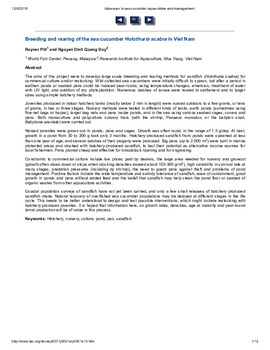Breeding and rearing of the sea cucumber Holothuria scabra in Viet Nam

Citation
Pitt, R.; Nguyen, D.Q.D (2004). Breeding and rearing of the sea cucumber Holothuria scabra in Viet Nam. FAO Fish. Tech. Pap. (463): 333-346
The aims of this project were to develop large scale breeding and rearing methods for sandfish (Holothuria scabra) for commercial culture and/or restocking. Wild collected sea cucumbers were initially difficult to spawn, but after a period in earthen ponds or seabed pens could be induced year-round, using temperature changes, emersion, treatment of water with UV light, and addition of dry phytoplankton. Numerous batches of larvae were reared to settlement and to larger sizes using simple hatchery methods. Juveniles produced in indoor hatchery tanks (mostly below 3 mm in length) were nursed outdoors to a few grams, or tens of grams, in two or three stages. Nursery methods were tested in different kinds of tanks, earth ponds (sometimes using fine-net bags or hapas), larger bag nets and pens inside ponds, and in the sea using various seabed cages, covers and pens. Both monoculture and polyculture nursery trials (with the shrimp, Penaeus monodon, or the babylon snail, Babylonia areolata) were carried out. Nursed juveniles were grown out in ponds, pens and cages. Growth was often rapid, in the range of 1-3 g/day. At best, growth in a pond from 30 to 300 g took only 3 months. Hatchery-produced sandfish from ponds were spawned at less than one year of age, and several batches of their progeny were produced. Big pens (up to 2 000 m²) were built in marine protected areas and stocked with hatchery-produced sandfish, to test their potential as alternative income sources for local fishermen. Pens proved cheap and effective for broodstock ripening and for ongrowing. Constraints to commercial culture include low prices paid by dealers, the large area needed for nursery and growout (growth often slows down or stops when stocking densities exceed about 150-300 g/m²), high variability in survival rate at many stages, predation pressures (including by shrimp), the need to guard pens against theft and problems of pond management. Positive factors include the wide temperature and salinity tolerance of sandfish, ease of containment, good growth in ponds and pens without added feed and the belief that sandfish may help clean the pond floor or seabed of organic wastes from other aquaculture activities. Coastal population surveys of sandfish have not yet been carried, and only a few small releases of hatchery produced sandfish made. Natural recovery of overfished sea cucumber populations may be delayed at different stages in the life cycle. This needs to be better understood to design and test possible interventions, which might include restocking with hatchery produced juveniles. It is hoped that information here, on growth rates, densities, age at maturity and year-round larval production will be of value in this process.
Permalink
Date Available
Type
Publisher
Countries
Copyright
CC BY 4.0
Research Themes
Topics
Language